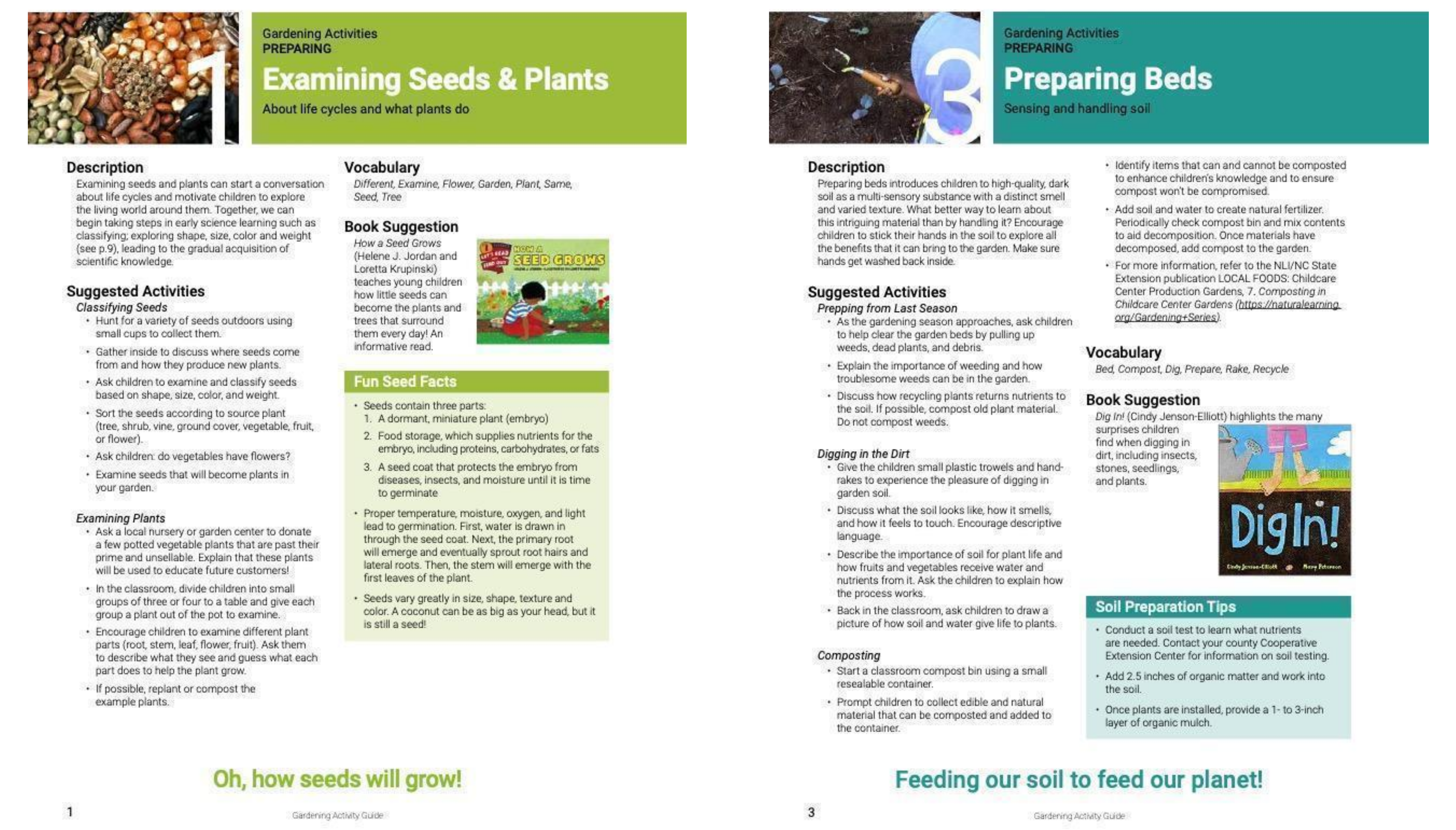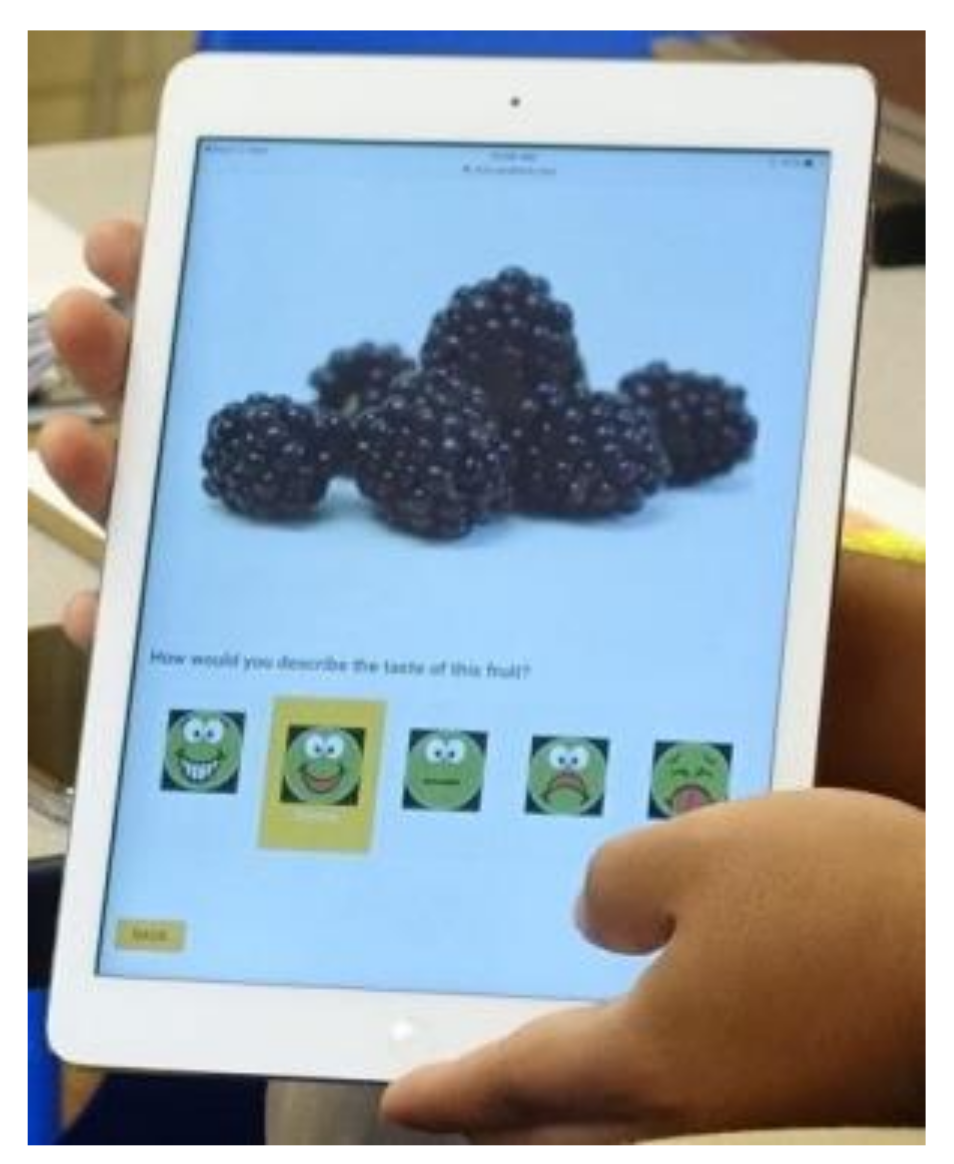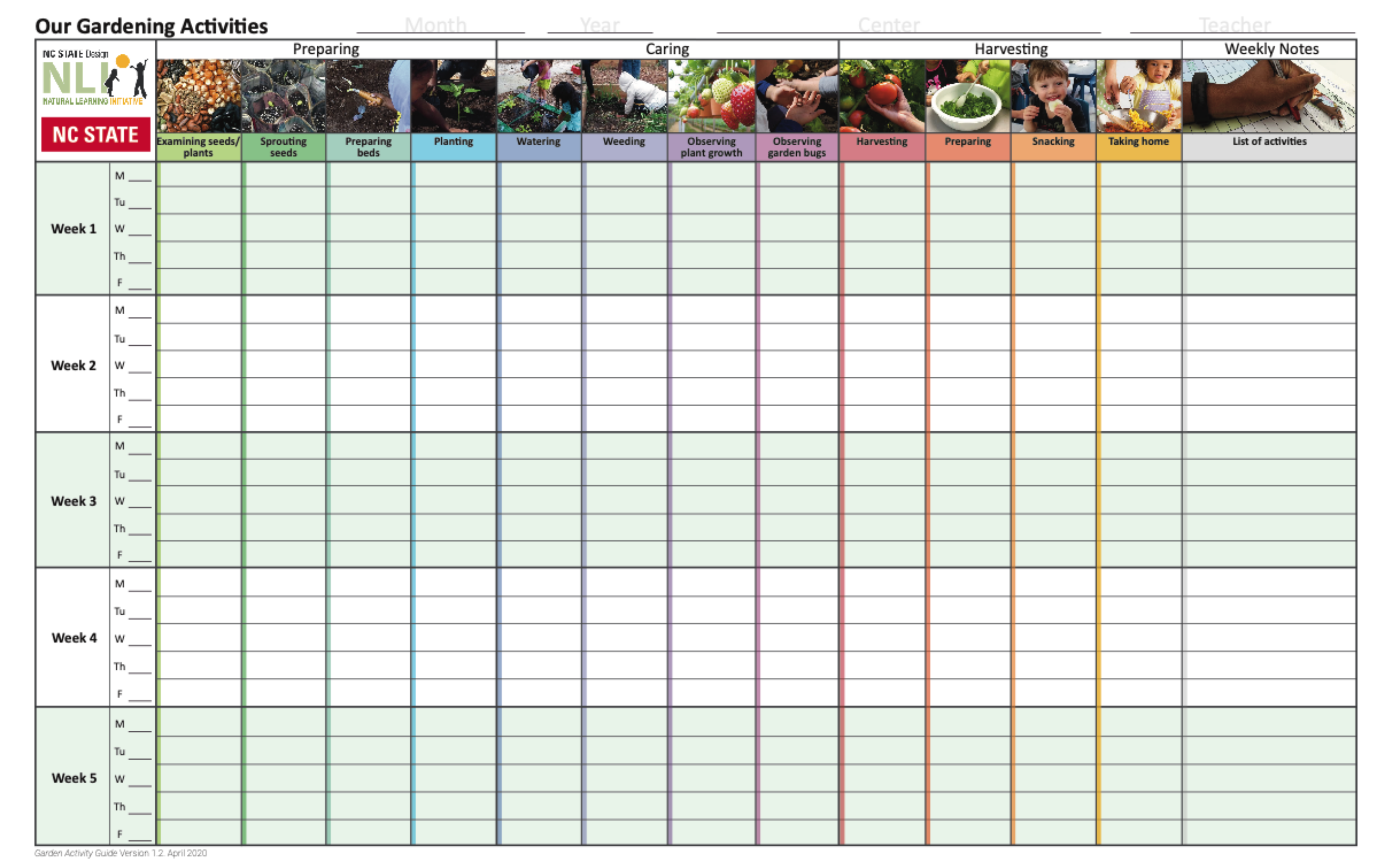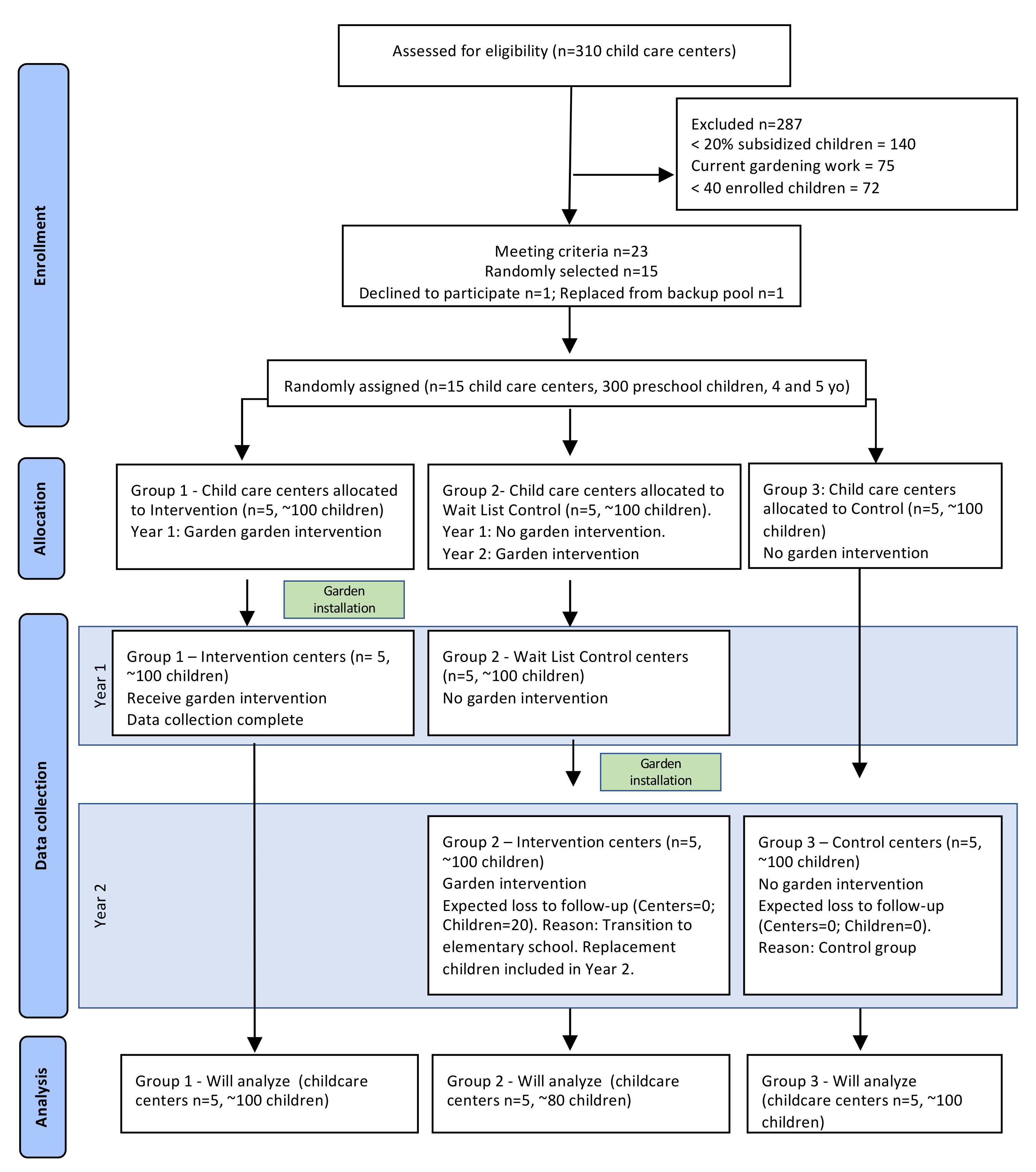Research Design, Protocol, and Participant Characteristics of COLEAFS: A Cluster Randomized Controlled Trial of a Childcare Garden Intervention
Abstract
1. Introduction
2. Materials and Methods
2.1. Study Design
2.2. Childcare Centers, Participants, and Recruitment
2.2.1. Center Recruitment and Randomization
2.2.2. Child Recruitment
2.3. Intervention Components
2.4. Constructs and Measures
2.4.1. FV Identification and FV Liking
2.4.2. FV Consumption
2.4.3. Physical Activity
2.4.4. Garden Fidelity Tool
2.5. Analytic Strategy
3. Results
Recruitment and Enrollment
Characteristics of the Randomized Groups
4. Discussion
5. Conclusions
Author Contributions
Funding
Institutional Review Board Statement
Informed Consent Statement
Data Availability Statement
Acknowledgments
Conflicts of Interest
References
- Tagtow, A.; Rahavi, E.; Bard, S.; Stoody, E.E.; Casavale, K.; Mosher, A. Coming together to communicate the 2015–2020 dietary guidelines for Americans. J. Acad. Nutr. Diet. 2016, 116, 209–212. [Google Scholar] [CrossRef] [PubMed]
- U. S. Department of Agriculture; U. S. Department of Health and Human Services. Dietary Guidelines for Americans, 2020–2025. Available online: https://www.dietaryguidelines.gov/sites/default/files/2020-12/Dietary_Guidelines_for_Americans_2020-2025.pdf (accessed on 20 September 2021).
- Guenther, P.M.; Dodd, K.W.; Reedy, J.; Krebs-Smith, S.M. Most Americans eat much less than recommended amounts of fruits and vegetables. J. Am. Diet. Assoc. 2006, 106, 1371–1379. [Google Scholar] [CrossRef] [PubMed]
- Pate, R.R.; O’Neill, J.R.; Brown, W.H.; Pfeiffer, K.A.; Dowda, M.; Addy, C.L. Prevalence of compliance with a new physical activity guideline for preschool-age children. Child. Obes. 2015, 11, 415–420. [Google Scholar] [CrossRef] [PubMed]
- Cunningham, S.A.; Kramer, M.R.; Narayan, K. Incidence of childhood obesity in the United States. N. Engl. J. Med. 2014, 370, 403–411. [Google Scholar] [CrossRef] [PubMed]
- Lowry Warnock, A.; Dooyema, C.; Blanck, H.M.; Lee, S.H.; Hall, K.; Geary, N.; Galuska, D.A. A Healthy Start: National Trends in Child Care Regulations and Uptake of Obesity Prevention Standards (2010–2018). Child. Obes. 2021, 17, 176–184. [Google Scholar] [CrossRef] [PubMed]
- Ogden, C.L.; Carroll, M.D.; Fakhouri, T.H.; Hales, C.M.; Fryar, C.D.; Li, X.; Freedman, D.S. Prevalence of obesity among youths by household income and education level of head of household—United States 2011–2014. Morb. Mortal. Wkly. Rep. 2018, 67, 186. [Google Scholar] [CrossRef]
- Cabalda, A.B.; Rayco-Solon, P.; Solon, J.A.A.; Solon, F.S. Home gardening is associated with Filipino preschool children’s dietary diversity. J. Am. Diet. Assoc. 2011, 111, 711–715. [Google Scholar] [CrossRef]
- Davis, J.N.; Spaniol, M.R.; Somerset, S. Sustenance and sustainability: Maximizing the impact of school gardens on health outcomes. Public Health Nutr. 2015, 18, 2358–2367. [Google Scholar] [CrossRef] [PubMed]
- Meinen, A.; Friese, B.; Wright, W.; Carrel, A. Youth Gardens Increase Healthy Behaviors in Young Children. J. Hunger Environ. Nutr. 2012, 7, 192–204. [Google Scholar] [CrossRef]
- Wells, N.M.; Myers, B.M.; Henderson, C.R. School gardens and physical activity: A randomized controlled trial of low-income elementary schools. Prev. Med. 2014, 69 (Suppl. S1), S27–S33. [Google Scholar] [CrossRef] [PubMed]
- Christian, M.S.; Evans, C.; Nykjaer, C.; Hancock, N.; Cade, J. Evaluation of the impact of a school gardening intervention on children’s fruit and vegetable intake. A randomised controlled trial. Int. J. Behav. Nutr. Phys. Act. 2014, 11, 99–123. [Google Scholar] [CrossRef]
- Landry, M.J.; van den Berg, A.E.; Hoelscher, D.M.; Asigbee, F.M.; Vandyousefi, S.; Ghaddar, R.; Jeans, M.R.; Waugh, L.; Nikah, K.; Sharma, S.V. Impact of a School-Based Gardening, Cooking, Nutrition Intervention on Diet Intake and Quality: The TX Sprouts Randomized Controlled Trial. Nutrients 2021, 13, 3081. [Google Scholar] [CrossRef] [PubMed]
- Davis, J.N.; Nikah, K.; Asigbee, F.M.; Landry, M.J.; Vandyousefi, S.; Ghaddar, R.; Hoover, A.; Jeans, M.; Pont, S.J.; Richards, D. Design and participant characteristics of TX sprouts: A school-based cluster randomized gardening, nutrition, and cooking intervention. Contemp. Clin. Trials 2019, 85, 105834. [Google Scholar] [CrossRef] [PubMed]
- Evans, C.E.; Ransley, J.K.; Christian, M.S.; Greenwood, D.C.; Thomas, J.D.; Cade, J.E. A cluster-randomised controlled trial of a school-based fruit and vegetable intervention: Project Tomato. Public Health Nutr. 2013, 16, 1073–1081. [Google Scholar] [CrossRef][Green Version]
- Wells, N.M.; Myers, B.M.; Todd, L.E.; Barale, K.; Gaolach, B.; Ferenz, G.; Aitken, M.; Henderson, C.R.; Tse, C.; Pattison, K.O. The effects of school gardens on children’s science knowledge: A randomized controlled trial of low-income elementary schools. Int. J. Sci. Educ. 2015, 37, 2858–2878. [Google Scholar] [CrossRef]
- Elder, G.H. The life course and human development. In Handbook of Child Psychology; Theoretical Models of Human Development; Damon, W., Lerner, R.M., Eds.; John Wiley & Sons, Inc.: New York, NY, USA, 1998; Volume 1. [Google Scholar]
- Wethington, E. An overview of the life course perspective: Implications for health and nutrition. J. Nutr. Educ. Behav. 2005, 37, 115–120. [Google Scholar] [CrossRef]
- Wheaton, B.; Gotlib, I.H. Trajectories and turning points over the life course: Concepts and themes. In Stress and Adversity Over the Life Course; Gotlib, I.H., Wheaton, B., Eds.; Cambridge University Press: Cambridge, UK, 1997; pp. 1–25. [Google Scholar] [CrossRef]
- Bronfenbrenner, U.; Morris, P. The ecology of developmental process. In Handbook of Child Psychology; Damon, W., Lerner, R.M., Eds.; John Wiley & Sons Inc.: Hoboken, NJ, USA, 1998; Volume 1, pp. 992–1028. [Google Scholar]
- Sallis, J.F.; Cervero, R.B.; Ascher, W.; Henderson, K.A.; Kraft, M.K.; Kerr, J. An Ecological Approach to Creating Active Living Communities. Annu. Rev. Public Health 2006, 27, 297–322. [Google Scholar] [CrossRef]
- Story, M.; Kaphingst, K.M.; French, S. The role of child care settings in obesity prevention. Future Child. 2006, 143–168. [Google Scholar] [CrossRef]
- National Center for Education Statistics. Enrollment Rates of Young Children. Available online: https://nces.ed.gov/programs/coe/indicator/cfa (accessed on 10 November 2021).
- Robinson-O’Brien, R.; Story, M.T.; Heim, S. Impact of Garden-Based Youth Nutrition Intervention Programs: A Review. J. Am. Diet. Assoc. 2009, 109, 273–280. [Google Scholar] [CrossRef] [PubMed]
- Larson, N.; Ward, D.S.; Neelon, S.B.; Story, M. What role can child-care settings play in obesity prevention? A review of the evidence and call for research efforts. J. Am. Diet. Assoc. 2011, 111, 1343–1362. [Google Scholar] [CrossRef] [PubMed]
- Waters, E.; de Silva-Sanigorski, A.; Burford, B.J.; Brown, T.; Campbell, K.J.; Gao, Y.; Armstrong, R.; Prosser, L.; Summerbell, C.D. Interventions for preventing obesity in children. Cochrane Database Syst. Rev. 2011, 12, 1–212. [Google Scholar] [CrossRef] [PubMed]
- Cosco, N.G.; Moore, R.C.; Smith, W.R. Childcare outdoor renovation as a built environment health promotion strategy: Evaluating the preventing obesity by design intervention. Am. J. Health Promot. 2014, 28, S27–S32. [Google Scholar] [CrossRef]
- National Center on Early Childhood Quality Assurance. QRIS Resource Guide; U.S. Department of Health and Human Services, Administration for Children and Families. Available online: https://ecquality.acf.hhs.gov/resource-guide (accessed on 11 November 2021).
- Hollar, D.; Messiah, S.; Lopez-Mitnik, G.; Hollar, T.; Almon, M.; Agatston, A. Effect of a Two-Year Obesity Prevention Intervention on Percentile Changes in Body Mass Index and Academic Performance in Low-Income Elementary School Children. Am. Public Health Assoc. 2011, 100, 646–653. [Google Scholar] [CrossRef] [PubMed]
- Division of Child Development and Early Education. Star Rated License. North Carolina Department of Health and Human Services. Available online: https://ncchildcare.ncdhhs.gov/Services/Licensing/Star-Rated-License (accessed on 20 September 2021).
- Centers for Disease Control and Prevention. Growth Chart Training. Available online: https://www.cdc.gov/nccdphp/dnpao/growthcharts/training/bmiage/index.html (accessed on 20 September 2021).
- Carraway-Stage, V.; Spangler, H.; Borges, M.; Goodell, L.S. Evaluation of a pictorial method to assess liking of familiar fruits and vegetables among preschool children. Appetite 2014, 75, 11–20. [Google Scholar] [CrossRef]
- Witt, K.E.; Dunn, C. Increasing fruit and vegetable consumption among preschoolers: Evaluation of color me healthy. J. Nutr. Educ. Behav. 2012, 44, 107–113. [Google Scholar] [CrossRef] [PubMed]
- Sirard, J.R.; Trost, S.G.; Pfeiffer, K.A.; Dowda, M.; Pate, R.R. Calibration and evaluation of an objective measure of physical activity in preschool children. J. Phys. Act. Health 2005, 2, 345–357. [Google Scholar] [CrossRef]
- Choi, L.; Ward, S.C.; Schnelle, J.F.; Buchowski, M.S. Assessment of wear/nonwear time classification algorithms for triaxial accelerometer. Med. Sci. Sports Exerc. 2012, 44, 2009. [Google Scholar] [CrossRef] [PubMed]
- Shadish, W.; Cook, T.D.; Campbell, D.T. Experimental and Quasi-Experimental Designs for Generalized Causal Inference; Houghton Mifflin: Boston, MA, USA, 2002. [Google Scholar]
- Wells, N.M.; Meyers, B.M.; Todd, L.E.; Henderson, C.R., Jr.; Barale, K.; Gaolach, B.; Ferenz, G.; Aitken, M.; Caroline, C.T.; Pattison, K.O. The carry-over effects of school gardens on fruit and vegetable availability at home: A randomized controlled trial with low-income elementary schools. Prev. Med. 2018, 112, 152–159. [Google Scholar] [CrossRef]
- Evans, A.; Ranjit, N.; Rutledge, R.; Medina, J.; Jennings, R.; Smiley, A.; Stigler, M.; Hoelscher, D. Exposure to multiple components of a garden-based intervention for middle school students increases fruit and vegetable consumption. Health Promot. Pract. 2012, 13, 608–616. [Google Scholar] [CrossRef] [PubMed]
- Tandon, P.S.; Walters, K.M.; Igoe, B.M.; Payne, E.C.; Johnson, D.B. Physical activity practices, policies and environments in Washington state child care settings: Results of a statewide survey. Matern. Child Health J. 2017, 21, 571–582. [Google Scholar] [CrossRef] [PubMed]
- EPA. Climate Change Indicators: Length of Growing Seasons. Available online: https://www.epa.gov/climate-indicators/climate-change-indicators-length-growing-season (accessed on 15 June 2021).
- CCAA. Child Care in America, 2012 State Fact Sheets; Childcare Aware of America: Arlington, VA, USA, 2012. [Google Scholar]







| Childcare Center Elegibility Criteria |
| (1) Assigned a 4 or 5 Star Rated License, NC Division of Child Development and Early Education |
| (2) Serve a majority of children eligible for the childcare subsidy programs |
| (3) Contain at least two preschool classrooms (3–5-year-old children) |
| (4) Commitment from two preschool teachers to support recruitment and data gathering |
| (5) Enrollment size within the middle third for Wake Co (excluding smallest + largest centers) |
| (6) Operate a regulated on-site kitchen to prepare food for snacks |
| (7) Employ cooking staff |
| (8) Operate a year-round calendar |
| (9) Own or lease current space for at least 5 years into the future |
| (10) Do not currently conduct on-site FV gardening but interested in implementing in the future |
| Group | n | Age (sd) | BMI (sd) | % Male | % Non-White | % Subsidy |
|---|---|---|---|---|---|---|
| Intervention | 61 | 3.17 (0.53) | 16.13 (1.31) | 50.80% | 58.90% | 44.30% |
| Waitlist | 119 | 3.15 (0.55) | 16.20 (1.63) | 44.90% | 62.20% | 47.90% |
| Control | 70 | 3.51 (0.56) | 15.97 (1.27) | 53.60% | 71.90% | 62.30% |
Publisher’s Note: MDPI stays neutral with regard to jurisdictional claims in published maps and institutional affiliations. |
© 2021 by the authors. Licensee MDPI, Basel, Switzerland. This article is an open access article distributed under the terms and conditions of the Creative Commons Attribution (CC BY) license (https://creativecommons.org/licenses/by/4.0/).
Share and Cite
Cosco, N.G.; Wells, N.M.; Monsur, M.; Goodell, L.S.; Zhang, D.; Xu, T.; Hales, D.; Moore, R.C. Research Design, Protocol, and Participant Characteristics of COLEAFS: A Cluster Randomized Controlled Trial of a Childcare Garden Intervention. Int. J. Environ. Res. Public Health 2021, 18, 13066. https://doi.org/10.3390/ijerph182413066
Cosco NG, Wells NM, Monsur M, Goodell LS, Zhang D, Xu T, Hales D, Moore RC. Research Design, Protocol, and Participant Characteristics of COLEAFS: A Cluster Randomized Controlled Trial of a Childcare Garden Intervention. International Journal of Environmental Research and Public Health. 2021; 18(24):13066. https://doi.org/10.3390/ijerph182413066
Chicago/Turabian StyleCosco, Nilda Graciela, Nancy M. Wells, Muntazar Monsur, Lora Suzanne Goodell, Daowen Zhang, Tong Xu, Derek Hales, and Robin Clive Moore. 2021. "Research Design, Protocol, and Participant Characteristics of COLEAFS: A Cluster Randomized Controlled Trial of a Childcare Garden Intervention" International Journal of Environmental Research and Public Health 18, no. 24: 13066. https://doi.org/10.3390/ijerph182413066
APA StyleCosco, N. G., Wells, N. M., Monsur, M., Goodell, L. S., Zhang, D., Xu, T., Hales, D., & Moore, R. C. (2021). Research Design, Protocol, and Participant Characteristics of COLEAFS: A Cluster Randomized Controlled Trial of a Childcare Garden Intervention. International Journal of Environmental Research and Public Health, 18(24), 13066. https://doi.org/10.3390/ijerph182413066





